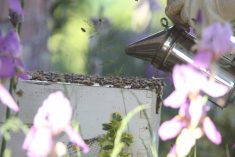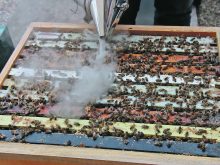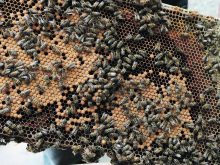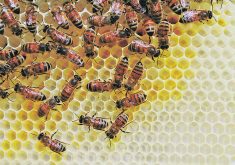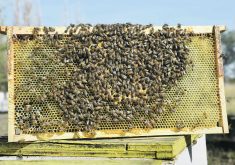New products to control varroa mites in honeybee colonies could be five years away from commercialization in Canada.
That’s a problem because varroa mites are developing resistance to Apivar, the only miticide on the market.
Some beekeepers are struggling right now to keep mites in check, so waiting until 2028 for a new miticide isn’t a great option.
“Our largest issue is miticides, control for our varroa mites,” said Curtis Miedema of Barrhead, Alta., president of the Alberta Beekeepers’ Commission.
“And we really don’t have anything really great on the horizon.”
Read Also

New coal mine proposal met with old concerns
A smaller version of the previously rejected Grassy Mountain coal mine project in Crowsnest Pass is back on the table, and the Livingstone Landowners Group continues to voice concerns about the environmental risks.
Varroa mites are relatively large, external parasites that attach themselves to honeybees, feeding on their bodily fluids.
The parasites weaken bees, making them more vulnerable to viruses and representing a major threat to bee colony health. Hives infested with varroa mites are less likely to survive the winter.
The good news is that bee experts in Western Canada are evaluating two potential miticides that could be replacements for Apivar.
The bad news is that it takes years to get such products to market.
“We have to have efficacy and safety data to make sure there are no side effects (from) this product,” said Medhat Nasr, a honeybee expert and former provincial apiculturist in Alberta.
For the last couple of years, Nasr has been working with the Saskatchewan Beekeepers Development Commission. He’s been testing miticides already commercialized and used to control mites in various crops to see if those products would be effective against varroa mites in bee hives.
The products are strips placed outside a beehive. A bee walks across them and carries the chemical into the hive, delivering it to the mite.
Once all the data is collected, showing it works and that it doesn’t harm bees or affect honey quality, the information will be submitted to Health Canada and the Pest Management Regulatory Agency for possible approval.
From now, the entire process could take four or five years, Nasr said.
That could be too late for some beekeepers.
“If all of a sudden we found ourselves without a synthetic miticide, winter losses would increase fairly significantly. And it would be that much harder to keep bees in Canada commercially viable,” said Nathan Wendell, president of the Saskatchewan beekeepers commission in 2022.
Beekeepers need a stop-gap solution to bridge the time until the new miticides hit the market.
The solution could be oxalic acid, an organic miticide that’s been around for a while.
“Oxalic acid is a registered miticide for varroa mite control, but has limitations,” Nasr said.
It works by delivering oxalic acid fumes to the mites, but a lot depends on how it is applied.
Sometimes the product breaks down into carbon dioxide and water, failing to transfer the necessary dose to the mites.
To remedy that issue, a Canadian company called Bee Health Pharma has developed an applicator and tablets for oxalic acid, which delivers a more consistent dose of the chemical.
Saskatchewan beekeepers are now working on a project, funded by the province and federal government, to “optimize” the use of oxalic acid on varroa mites.
“(The) proper dose at the right time, how many applications … that’s to be determined by the project,” Nasr said.
“That way we can help to keep the bees healthy … until we have the new tools (miticides).”






